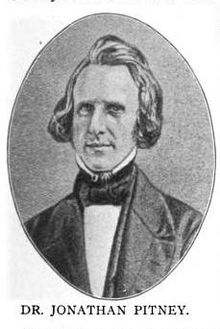
Most older locals know that Dr. Jonathan Pitney of Absecon was the visionary who created Atlantic City in 1854. He believed the fresh air, sunshine, and salt water at the Jersey Shore would restore health to people who suffered through hot summers in crowded cities like Philadelphia. He teamed up with Sam Richards of Hammonton who had wealth and financial and political connections needed to build a railroad to the empty barrier island that became Atlantic City. Few know that ten years earlier, he was a delegate to the convention that re-wrote NJ’s State Constitution.
In 1844, New Jersey adopted a new state constitution that quickly transformed our state into a debt free, low tax, economic powerhouse.
An important feature of this new state constitution was a new provision that required voter approval of all new state government debt. One of the delegates to Constitutional Convention that drafted it was Dr. Jonathan Pitney of Absecon. Pitney was the remarkable visionary who caused Atlantic City to be built on a deserted barrier island ten years later.
During that time, most other states also changed their state constitutions to include similar provisions. Those provisions, with minor modifications, remain in our New Jersey State Constitution today.
Those new State Constitutions were created in response to the economic disaster that began with the “Panic of 1837”. The “Panic of 1837” was a series of bank failures. It triggered a six year nationwide economic depression, and years of state tax increases to payoff massive state government debts
The banks failed when state governments throughout America were “unable to pay their loans” because “many infrastructure projects failed to generate projected revenues”. Nine states “defaulted on interest payments and four repudiated all or part of their debts”. There was also a “resulting wave of tax increases to pay off the state debts blithely assumed in prior years. . .” (From Columbia Professor Richard Briffault, “The Fiscal Provisions of American State Constitutions”.)
Economic History Professor John J. Wallis observed that in 1841, the 26 states then in the United States had an aggregate debt $198 million, while the total federal government debt that year was $5.25 million.
These years of widespread failure, poverty, and hunger in a nation that had previously known success and prosperity had a profound emotional impact on America that lasted for years. This was captured by the popular song “Hard Times Come Again No More”, written by Stephen Foster ten years later.
Professor Wallis claimed that this unsustainable state government debt was created by “systematic corruption” in most state governments at that time.
According to Wallis, elected state government officials had enormous power to grant monopoly privileges, corporate charters, and loans to whichever selected business owners they chose. At the same time, business owners could and did use their resources to elect and reward politicians who favored them over competitors in getting these favors.
During the 1840’s, New Jersey and most states adopted new state constitutions or constitutional provisions to address the twin problems of systemic corruption and unsustainable debt. Professor John J. Wallis found their solutions “simple” and “ingenious”.
“First, states eliminated the pressure to create special corporate privileges by enacting constitutional provisions requiring legislatures to pass general incorporation laws allowing unlimited entry into corporate status via an administrative procedure. Second, states passed constitutional provisions requiring that all state borrowing required a bond referendum mandating that the higher taxes necessary to service the bonds be approved by voters before the bonds were issued. Third, most states forbade state and local investment in private corporations”.
By 1902, New Jersey had eliminated its bonded debt and abolished its state property tax. (Property taxes to fund public schools and county and local governments, of course, remained.)
New Jersey did not have a state sales tax until 1963. It did not have a state income tax until 1976. It had the lowest motor fuels taxes in America until 2017.
In 1963, New Jersey adopted a new 3% state sales tax “to make real state taxes affordable”. Starting in 1968, the New Jersey Supreme Court approved various “evasive techniques*” and “backdoor financing*” used by state government to borrow large amounts without voter approval. (Terms used by Professor Richard Briffault.)
By 2008, Democratic Governor Jon Corzine publicly complained that although “our State Constitutions have explicitly barred borrowing without voter approval. . . (s)omewhere along the line, the meaning of that requirement got totally lost”.
Corzine said in 2008 that New Jersey government had $32 billion in bonded debt that was unstainable. Today, New Jersey government has more than $234.7 billion of public debt! That includes roughly $200 billion in unfunded pension and retiree medical benefits.
Governor Murphy and the Democrat majority in the legislature approved a plan to borrow $9.7 billion more. We file suit to try to stop them unless they put the issue on a Ballot Question in November, and get the approval of voters.
Click the link below to view our complete 19 Page Amicus Curiae (Frend of the Court) brief that we filed with the State Supreme Court.
We are a group of 150 ordinary citizens who mostly live near Atlantic City, New Jersey. We volunteer our time and money to maintain this website. We do our best to post accurate information. However, we admit we make mistakes from time to time. If you see any mistakes or inaccurate, misleading, outdated, or incomplete information in this or any of our posts, please let us know. We will do our best to correct the problem as soon as possible.
Seth Grossman, Executive Director
(609) 927-7333.

